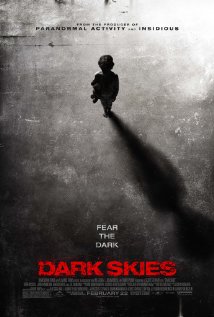I came to When the Lights Went Out with absolutely
no fixed ideas or suppositions – something rare in this age of
information saturation. With somewhat misleading posters and hooks (based on a
true story is probably one axiom in the horror climate certain to provoke distrust), I was somewhat surprised to find a domestic
ghost story that is both intriguing and
alternative: light years away from the usual forged glamour peddled out every
time a major studio attempts to translate something rooted in truth.
When the Lights Went Out
is based on The Black Monk of Pontefract (a 1974 British poltergeist haunting occurring in the home of Joe and Jean Pritchett). The real-life case in
Yorkshire – although never reaching the lofty global proportions of The Amityville Horror – was still devastating to the local community as a
whole. One of the greatest strengths of this film is a viewer’s curiosity
will be piqued enough to seek out the true story for themselves. Thankfully bereft of any found footage tropes,
the makers have still managed to craft a sobering reality reflective of
working-class life in Yorkshire during a time of industrial recession and
constant electrical blackouts.
As
a haunted house tale, the beginning is a familiar one: the Maynard's have
purchased a new suburban house in the pursuit of new beginnings. Len, Jenny,
and daughter Sally are an archetypal working class family. Hauntings begin subtly
but then quickly dovetail into abrasive acts singling out young Sally at the
center of the maelstrom. Momentarily stagnant and with no way to escape their
dilemma, Len turns to the local media in order to make some quick cash. At this juncture, other residents of the town are drawn into the family’s
plight: most notably Sally’s best friend and her high-school teacher ... a man
who then becomes charged with discovering the identity of the presence in
residence.
What
other reviewers have pointed out (and what is outwardly obvious), is there is
nothing here we haven’t seen before. Instead, it excels in other
avenues – markedly how the production has brought to life the aching
nostalgia of a certain period. Here all things seventies have been evoked with an uncanny
attention to detail: retro cars, flairs, haircuts ... even the carpets and
wallpaper. Merge all of this with the cockney accents and you have a fitting
movie even without the supernatural overtones. Although things are measured and
leisurely in this regard (the supernatural), there are just enough key moments
of genuine creepiness to make this Yorkshire ghost tale worth the telling.
When the human element of the haunting comes into play (relationships ripped
asunder because of doubt and suspicion), we see a vulnerable side of the family bordering on heartbreaking. The climax, though riddled with unnecessary
special effects, is surprisingly one of hope ... something all too rare among the
current crop of modern supernatural cinema.
All
told, this is an excursion that will not go down among the pantheon of
classics; however, I can recommend it
for the domestic component alone. Dark, diverse, and above all atypical, When the Lights Went Out is subtle
viewing for those of us exhausted by the franchise mill.


.jpg)
